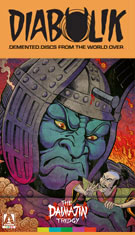
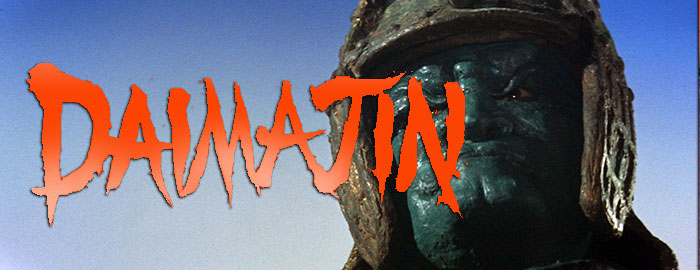
DAIMAJIN
Color, 1966, 83 mins. 46 secs.
Directed by Kimiyoshi Yasuda
Starring
Miwa Takada, Yoshihiko Aoyama, Jun Fujimaki, Ryutaro Gomi
RETURN OF DAIMAJIN
Color, 1966, 78 mins. 56 secs.
Directed by Kenji Misumi
Starring
Kôjirô Hongô, Shiho Fujimura, Tarô Marui, Takashi Kanda
WRATH OF DAIMAJIN
Color,
1966, 87 mins. 18 secs.
Directed by Kazuo Mori
Starring
Hideki Ninomiya, Shinji Hori, Masahide Iizuka, Muneyuki Nagatomo, Tôru Abe
Arrow Video (Blu-ray) (US/UK RA/RB HD), Mill Creek (Blu-ray) (US RA HD), Kadokawa (Blu-ray & DVD) (Japan RA/R1 HD/NTSC), AD Vision (DVD) (US R1 NTSC) / WS (2.35:1) (16:9)
 Japanese cinema enjoying unprecedented
Japanese cinema enjoying unprecedented 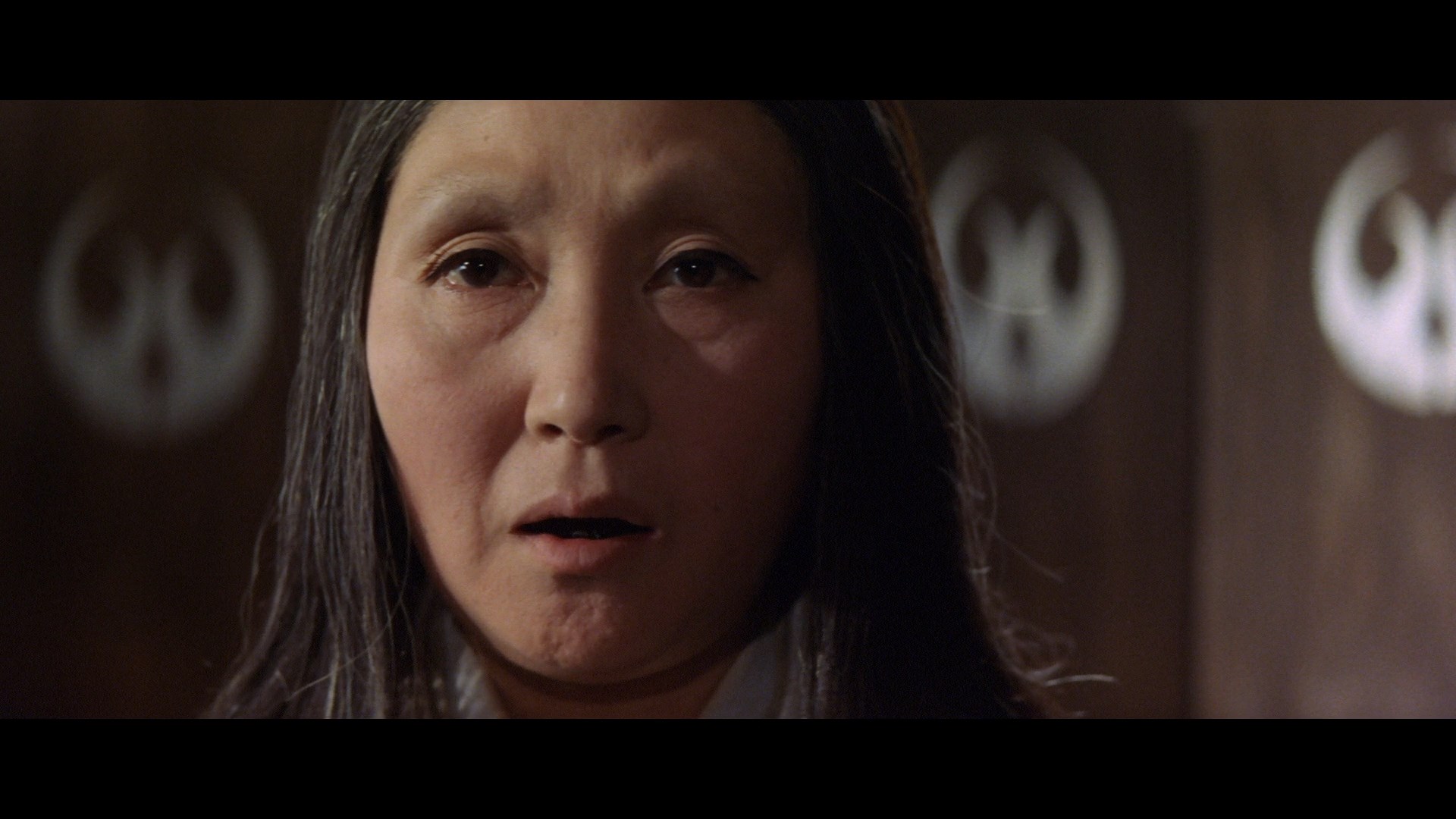 global exposure from the art house to monster movie matinees, each studio was busy churning out dozens of films each year to meet the demand. One of the most prolific of these was Daiei Film, which found success with its Gamera and Zatoichi series along with shorter and more outlandish curios like the Yokai Monsters films. Though initially treated as disposable giant monster fodder in the U.S., the three Daimajin films produced in 1966 have become one of its best-loved genre contributions, with each production offering a standalone story and different director while retaining some valuable crew members like composer Akira Ifukube of Godzilla series fame and cinematographer Fujio Morita, the latter working in scope and very saturated, stylized color.
global exposure from the art house to monster movie matinees, each studio was busy churning out dozens of films each year to meet the demand. One of the most prolific of these was Daiei Film, which found success with its Gamera and Zatoichi series along with shorter and more outlandish curios like the Yokai Monsters films. Though initially treated as disposable giant monster fodder in the U.S., the three Daimajin films produced in 1966 have become one of its best-loved genre contributions, with each production offering a standalone story and different director while retaining some valuable crew members like composer Akira Ifukube of Godzilla series fame and cinematographer Fujio Morita, the latter working in scope and very saturated, stylized color.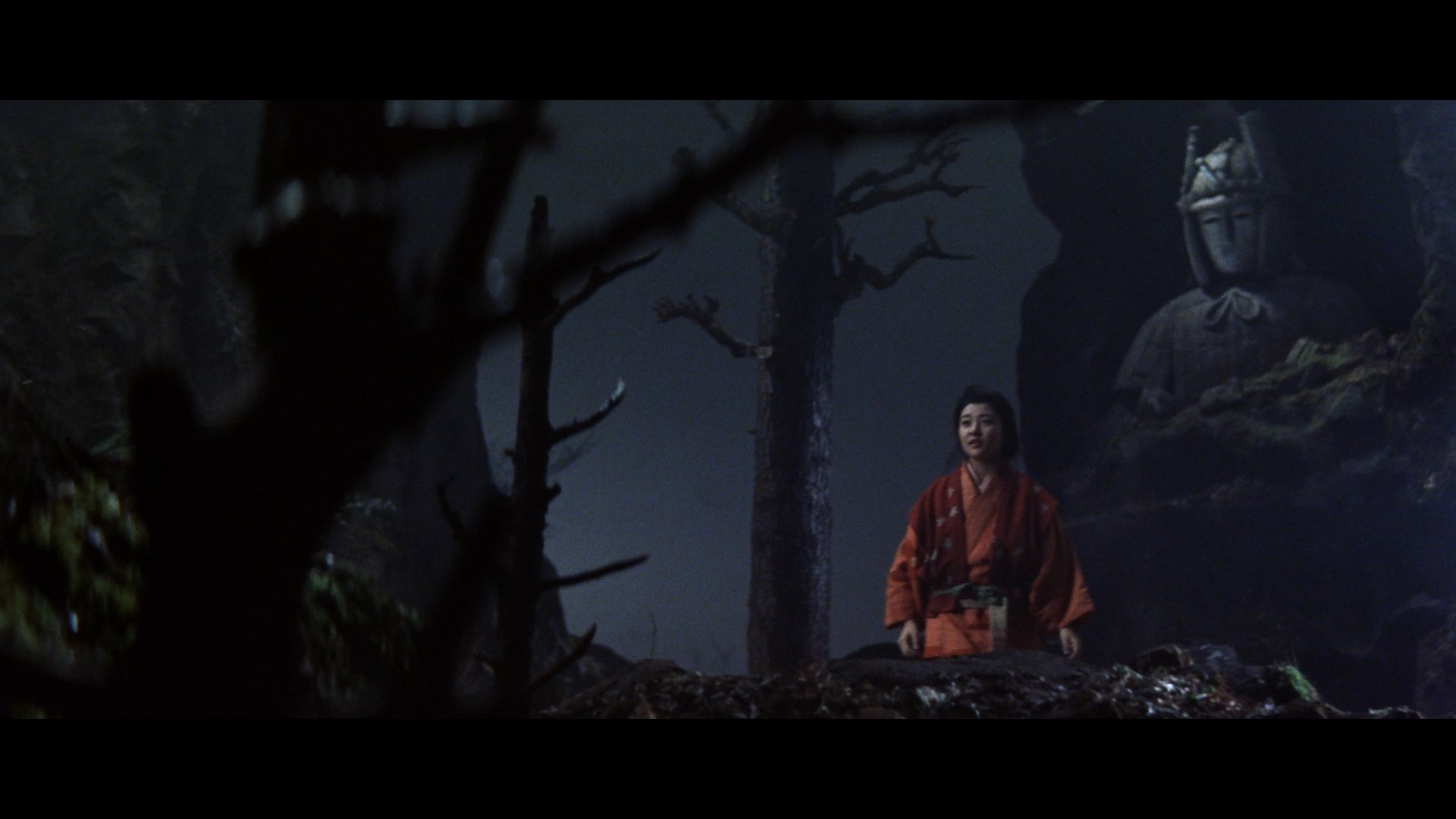 forbids the regular ceremonies intended to keep the being at bay in his natural home, while the
forbids the regular ceremonies intended to keep the being at bay in his natural home, while the 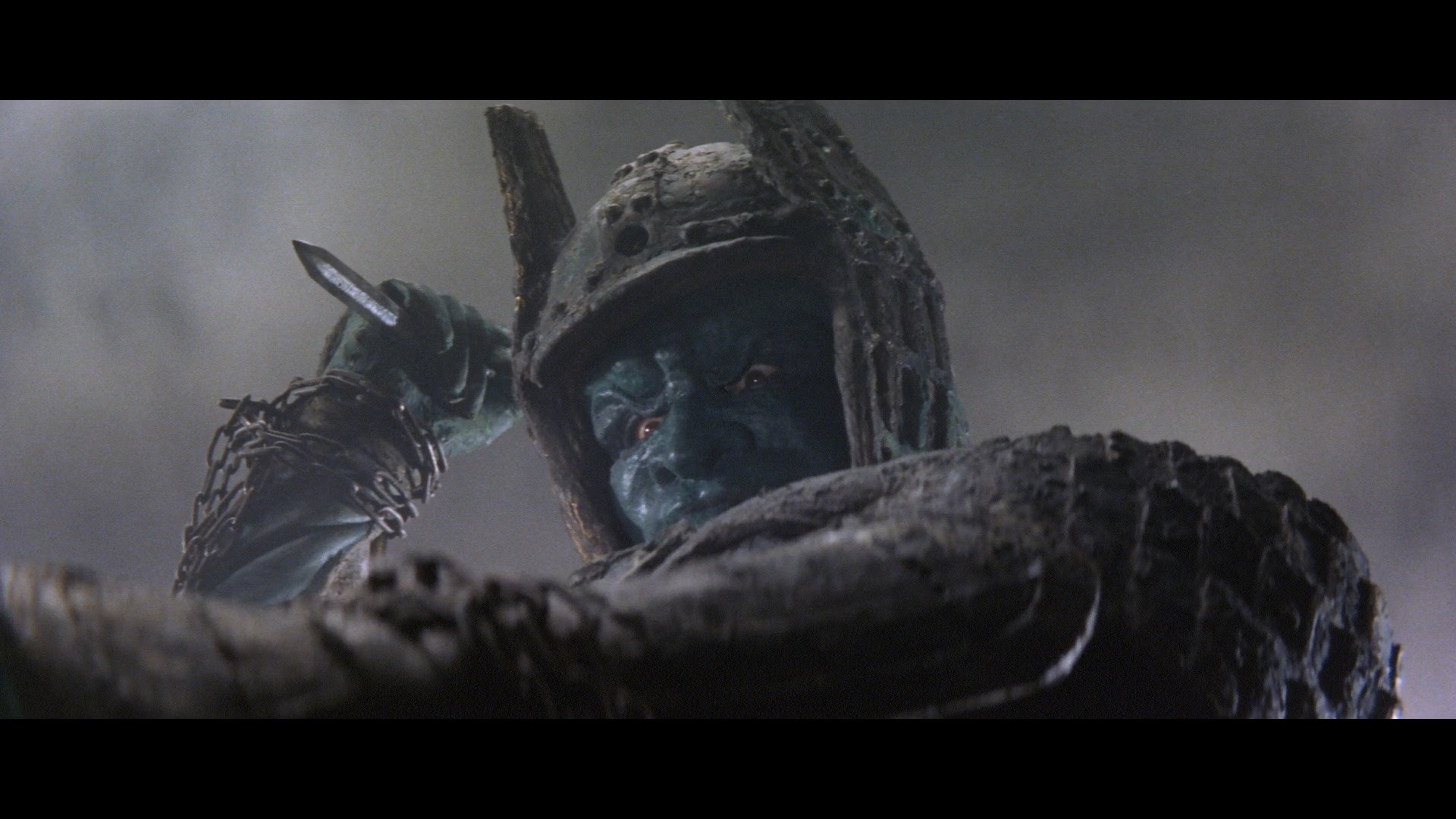 two children of the village's slain leader are spirited away to a remote temple where they grow up to adulthood as Tadafumi (Aoyama) and Kozasa (Takada). As the land falls under increasingly brutal tyranny, the siblings and the townspeople become more desperate for their slighted guardian to step in and take action -- though the price could be more destructive than they're willing to pay.
two children of the village's slain leader are spirited away to a remote temple where they grow up to adulthood as Tadafumi (Aoyama) and Kozasa (Takada). As the land falls under increasingly brutal tyranny, the siblings and the townspeople become more desperate for their slighted guardian to step in and take action -- though the price could be more destructive than they're willing to pay.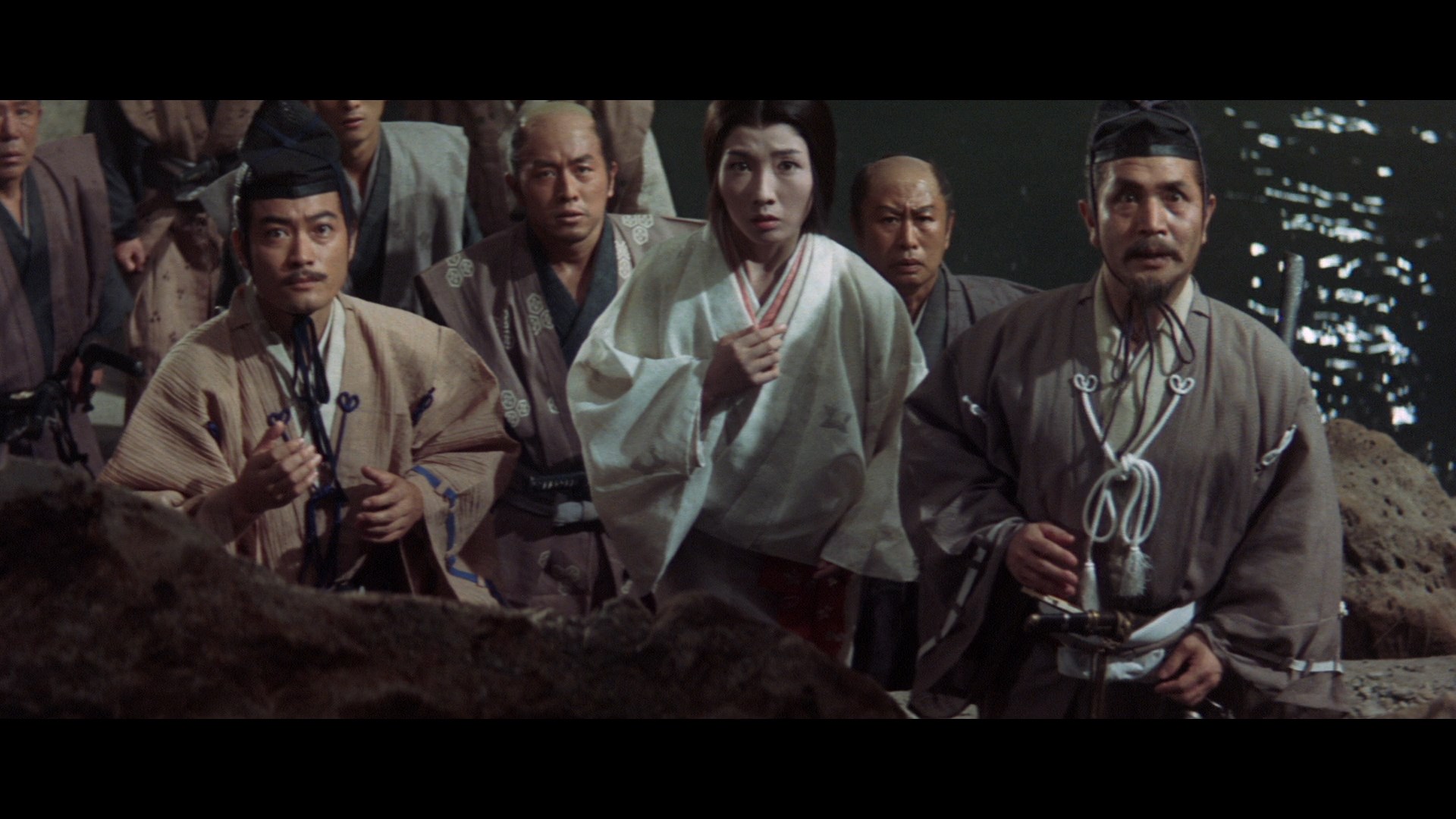 toll and many kaiju films heading straight to U.S. television sometimes
toll and many kaiju films heading straight to U.S. television sometimes 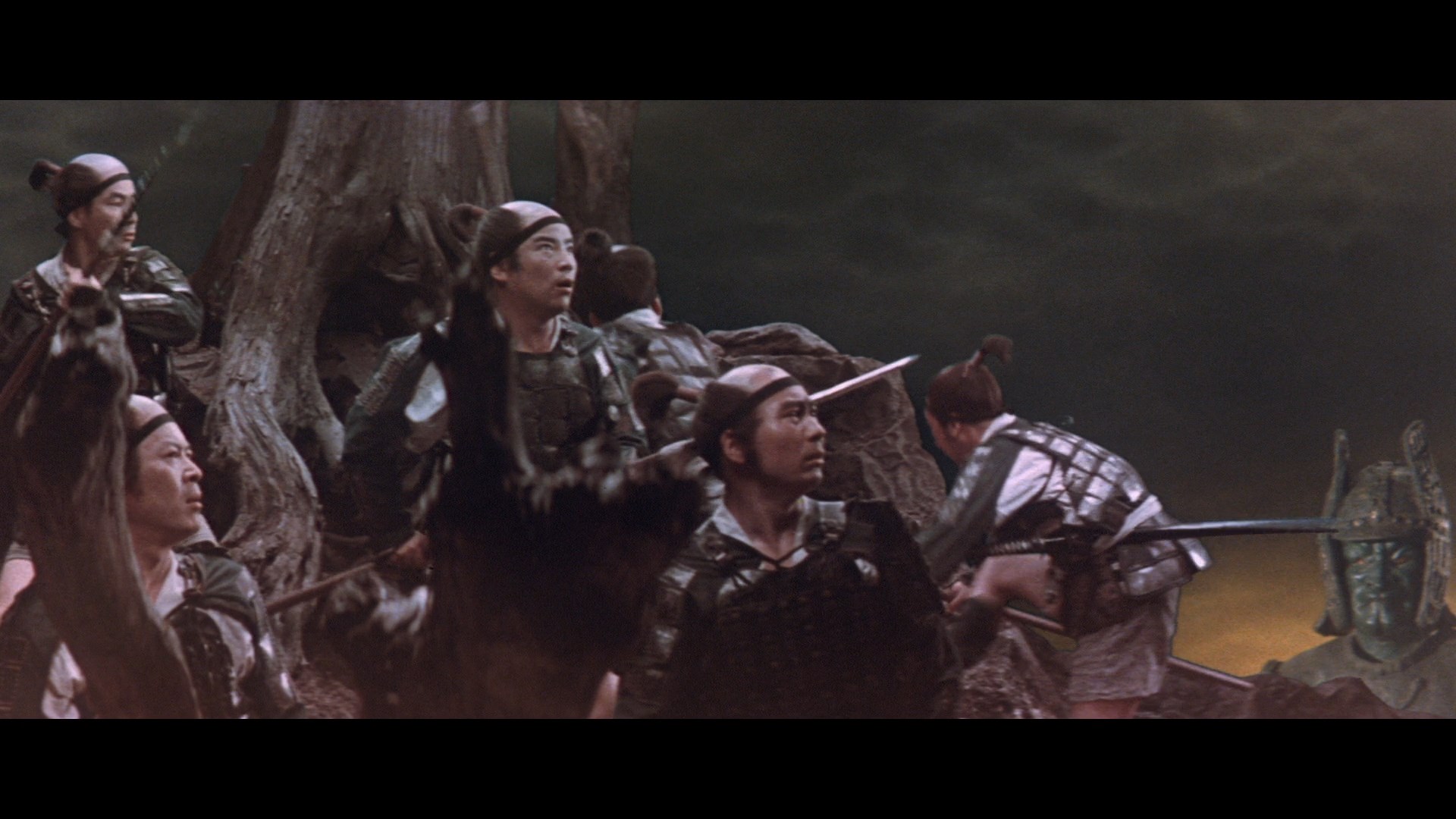 well after the fact. Ultimately it was a gamble that didn't quite pay off when Daiei leaped straight into the second film, The Return of Daimajin, which essentially riffs on the same formula of an evil lord inflicting suffering on the common people who rely on their idol to come to their rescue. This time Lone Wolf and Cub director Kenji Misumi (who also helmed the Sleepy Eyes of Death films and the wild Hanzo the Razor: Sword of Justice) takes over for the story of another corrupt and power-mad lord who drives a steady stream of the populace into two neighborhood villages for help. Determined to crack down on the refugees, he interrupts another Daimajin ceremony and decides he'll not only inflict harm on the villagers but wreck that statue as well. Of course, that turns out to be a supremely bad idea. Essentially a replay of the first film but with a bigger cast of ostracized protagonists, this is paced almost identically with lots of persecution leading up to the inevitable payback and a frantic decision about what to do with that gigantic stone god once he's served his purpose. It's nicely handled though with even more ambitious special effects at the end, making it a fine if somewhat familiar follow-up.
well after the fact. Ultimately it was a gamble that didn't quite pay off when Daiei leaped straight into the second film, The Return of Daimajin, which essentially riffs on the same formula of an evil lord inflicting suffering on the common people who rely on their idol to come to their rescue. This time Lone Wolf and Cub director Kenji Misumi (who also helmed the Sleepy Eyes of Death films and the wild Hanzo the Razor: Sword of Justice) takes over for the story of another corrupt and power-mad lord who drives a steady stream of the populace into two neighborhood villages for help. Determined to crack down on the refugees, he interrupts another Daimajin ceremony and decides he'll not only inflict harm on the villagers but wreck that statue as well. Of course, that turns out to be a supremely bad idea. Essentially a replay of the first film but with a bigger cast of ostracized protagonists, this is paced almost identically with lots of persecution leading up to the inevitable payback and a frantic decision about what to do with that gigantic stone god once he's served his purpose. It's nicely handled though with even more ambitious special effects at the end, making it a fine if somewhat familiar follow-up. Daimajin (more commonly known before this as Daimajin Strikes Again) switches the scenery to a snowy landscape and
Daimajin (more commonly known before this as Daimajin Strikes Again) switches the scenery to a snowy landscape and 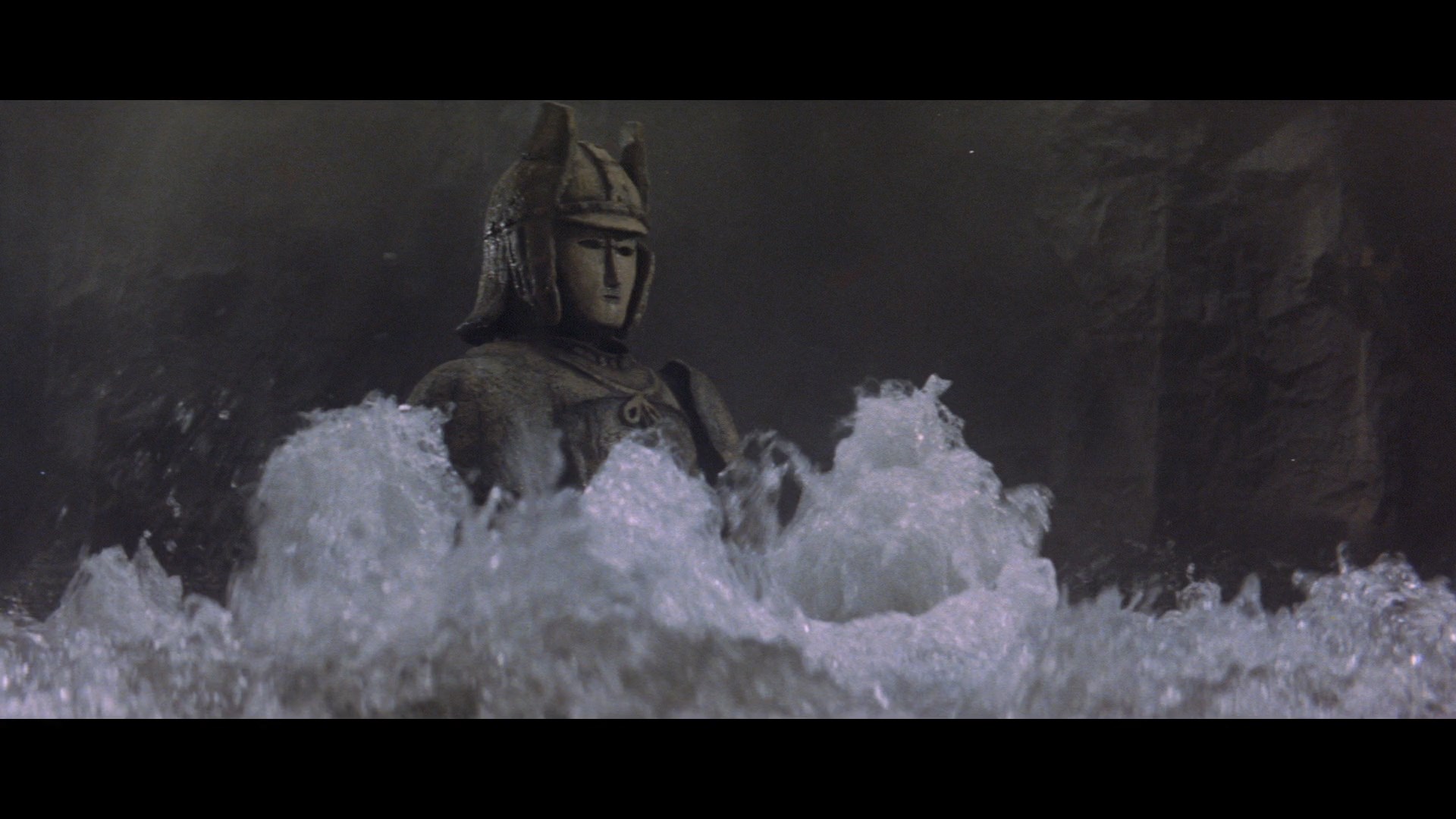 obviously amps up the kiddie factor to go for the same audience as the Gamera films at the time. The gambit didn't work and the film barely got any theatrical play in Japan, not even getting top-tier double feature play with other Daiei films and effectively closing the door on the official trilogy. Here that pivotal statue is transported to a remote, snow-covered mountain along a path where another tyrant, Lord Arakawa (Blind Woman's Curse's Abe), keeps swiping helpless adult male villagers to become forced laborers. Four of the abductees' children decide to make a perilous winter trek to help them and encounter the Daimajin, who of course appreciates their respectful treatment of him and is less appreciative of the exploitation going on nearby. This one shakes things up a bit (apart from the kid emphasis) by giving us the usual monster stomping at the end shading with heavy snow flurries, a nice change from the usual bright afternoon sun and billowing dust that defined the previous two films. Unlike the prior two films, this one didn't even go to American TV and remains less seen and discussed overall, but again it's quite entertaining and visually lavish with a climax that certainly delivers.
obviously amps up the kiddie factor to go for the same audience as the Gamera films at the time. The gambit didn't work and the film barely got any theatrical play in Japan, not even getting top-tier double feature play with other Daiei films and effectively closing the door on the official trilogy. Here that pivotal statue is transported to a remote, snow-covered mountain along a path where another tyrant, Lord Arakawa (Blind Woman's Curse's Abe), keeps swiping helpless adult male villagers to become forced laborers. Four of the abductees' children decide to make a perilous winter trek to help them and encounter the Daimajin, who of course appreciates their respectful treatment of him and is less appreciative of the exploitation going on nearby. This one shakes things up a bit (apart from the kid emphasis) by giving us the usual monster stomping at the end shading with heavy snow flurries, a nice change from the usual bright afternoon sun and billowing dust that defined the previous two films. Unlike the prior two films, this one didn't even go to American TV and remains less seen and discussed overall, but again it's quite entertaining and visually lavish with a climax that certainly delivers.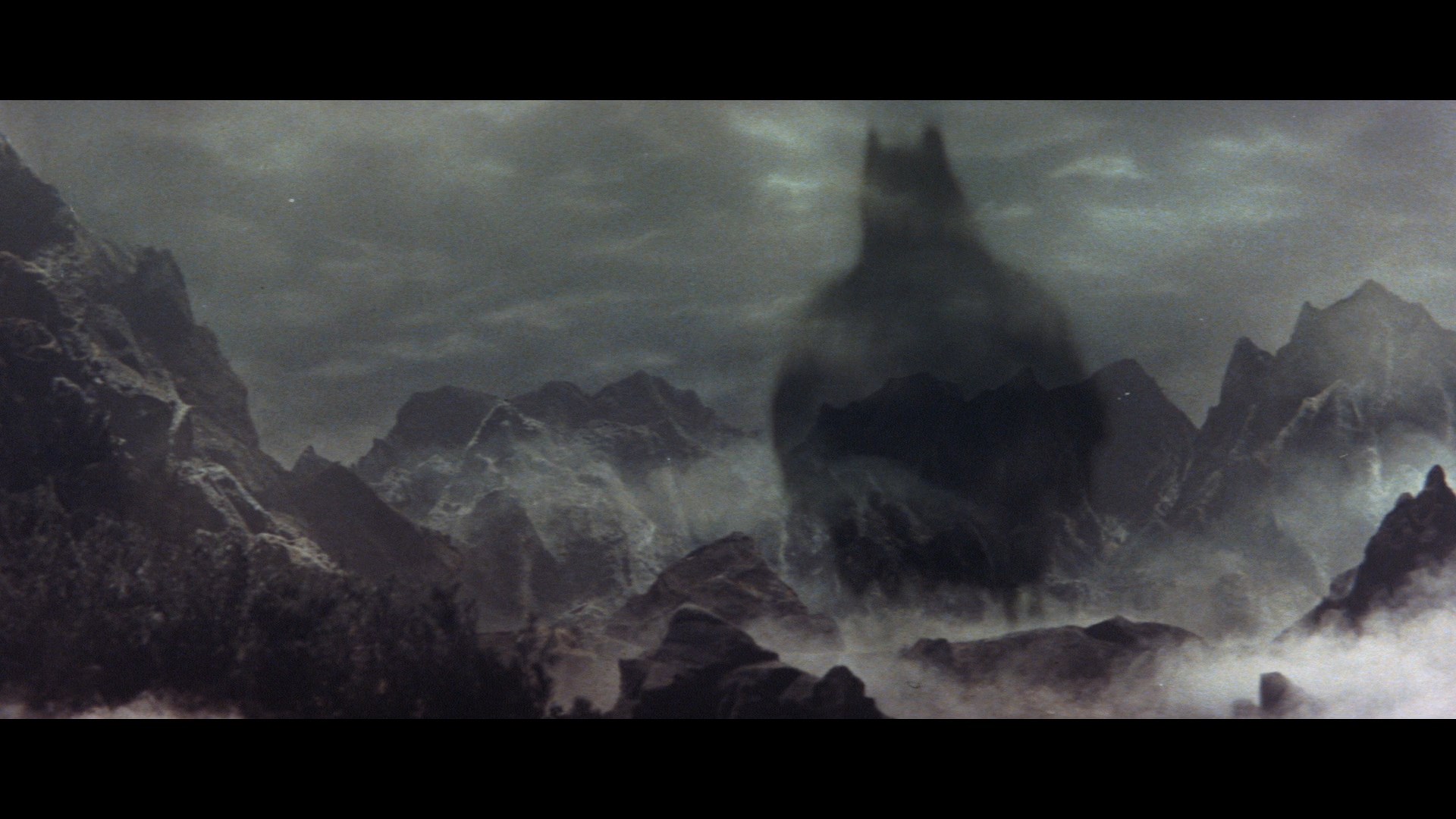 31m4s, and 28m21s) with Morita created for the Japanese home video releases. In 2021, Arrow Video gave the films a big
31m4s, and 28m21s) with Morita created for the Japanese home video releases. In 2021, Arrow Video gave the films a big 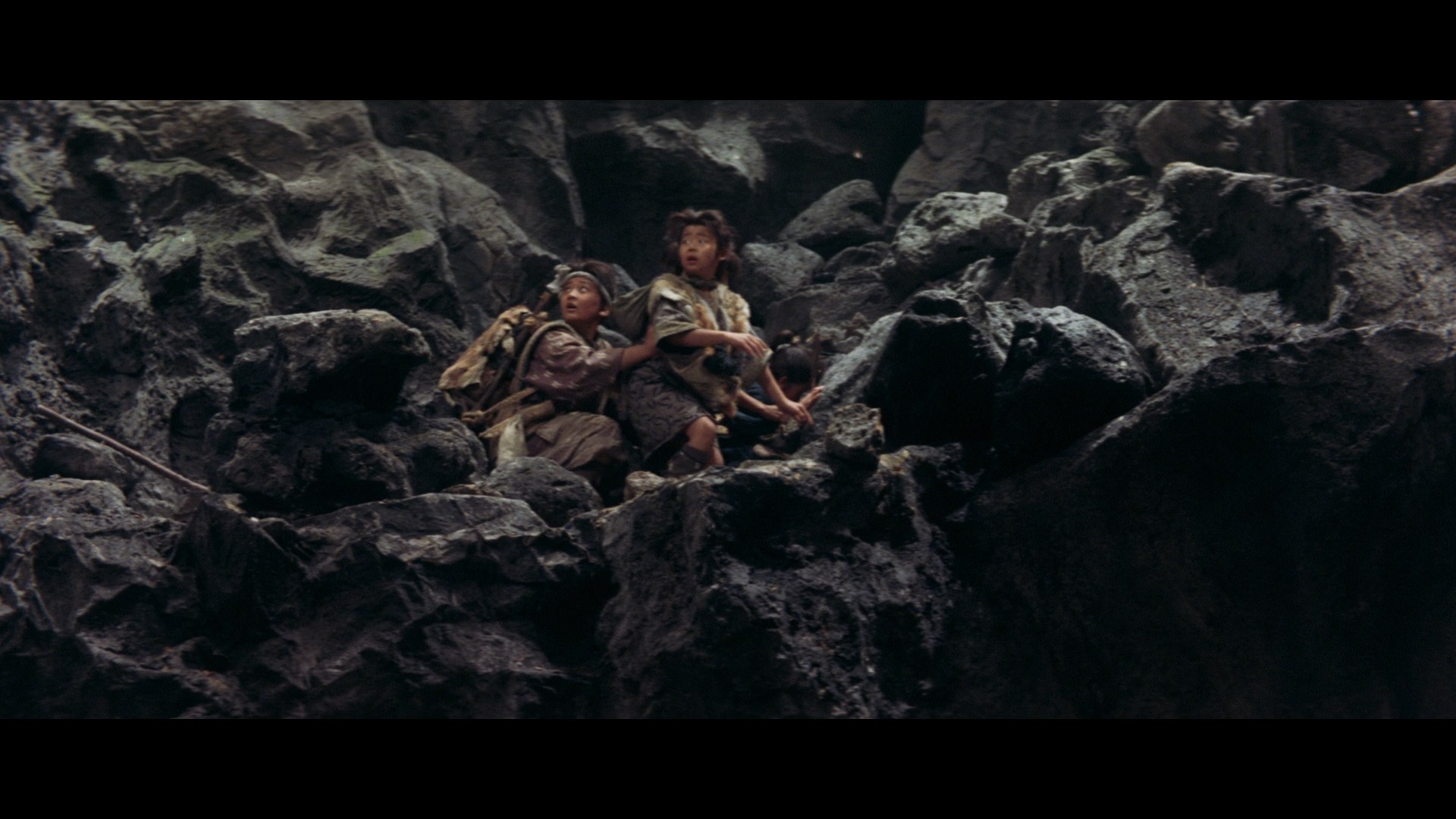 upgrade with a limited edition Blu-ray set in the U.S. and U.K., complete with the usual opulent packaging including a 100-page illustrated book featuring new essays by Jonathan Clements, Keith Aiken, Ed Godziszewski, Raffael Coronelli, Erik Homenick, Robin Gatto and Kevin Derendorf, plus poster-replica postcards. This also marks the first official home video release of any kind for these films in the U.K., where you were pretty much out of luck prior to this unless you felt like paying some steep import costs. The transfers on the old Mill Creek set were nice but compromised by low bit rates and some iffy compression; it's nice to see the films looking better here a decade later with each film given its own superior authoring on its own disc, with DTS-HD MA original Japanese and English dubs with optional English subtitles. They all look and sound very good, about on par with Arrow's other Daiei titles. Each film also comes with a new audio commentary: Stuart Galbraith IV on Daimajin (focusing on the films' relevance to Japanese fantastic cinema and the cultural factors involved as well as some insightful looks at related narratives like the Golem folklore and its cinematic interpretations); Tom Mes and Jasper Sharp on Return, starting off explaining how they discovered the series and focusing heavily on the studio's history and the larger connections to Japanese cinema at large; and Jonathan Clements on Wrath, charting the quick disappearance of the series, the seasonal changes from one film to the next intended to time with their theatrical releases, the variations on the mythology here, and the obvious ties to the progression of the Gamera series. Each track doesn't really overlap much at all, and they're all fine listening with a unique perspective.
upgrade with a limited edition Blu-ray set in the U.S. and U.K., complete with the usual opulent packaging including a 100-page illustrated book featuring new essays by Jonathan Clements, Keith Aiken, Ed Godziszewski, Raffael Coronelli, Erik Homenick, Robin Gatto and Kevin Derendorf, plus poster-replica postcards. This also marks the first official home video release of any kind for these films in the U.K., where you were pretty much out of luck prior to this unless you felt like paying some steep import costs. The transfers on the old Mill Creek set were nice but compromised by low bit rates and some iffy compression; it's nice to see the films looking better here a decade later with each film given its own superior authoring on its own disc, with DTS-HD MA original Japanese and English dubs with optional English subtitles. They all look and sound very good, about on par with Arrow's other Daiei titles. Each film also comes with a new audio commentary: Stuart Galbraith IV on Daimajin (focusing on the films' relevance to Japanese fantastic cinema and the cultural factors involved as well as some insightful looks at related narratives like the Golem folklore and its cinematic interpretations); Tom Mes and Jasper Sharp on Return, starting off explaining how they discovered the series and focusing heavily on the studio's history and the larger connections to Japanese cinema at large; and Jonathan Clements on Wrath, charting the quick disappearance of the series, the seasonal changes from one film to the next intended to time with their theatrical releases, the variations on the mythology here, and the obvious ties to the progression of the Gamera series. Each track doesn't really overlap much at all, and they're all fine listening with a unique perspective. 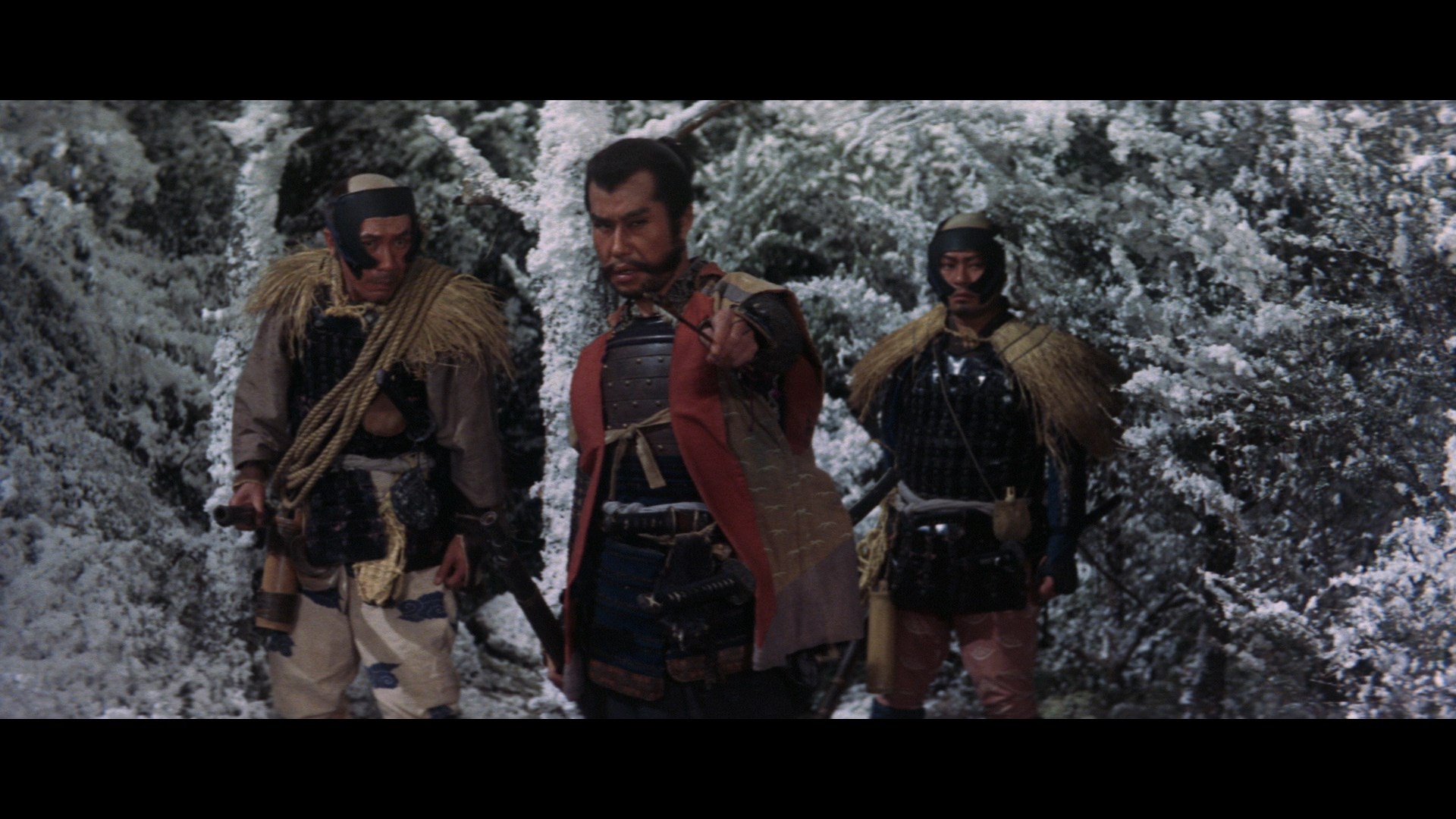 reliable Kim Newman (15m23s) who cheerfully examines how each films offers a
reliable Kim Newman (15m23s) who cheerfully examines how each films offers a 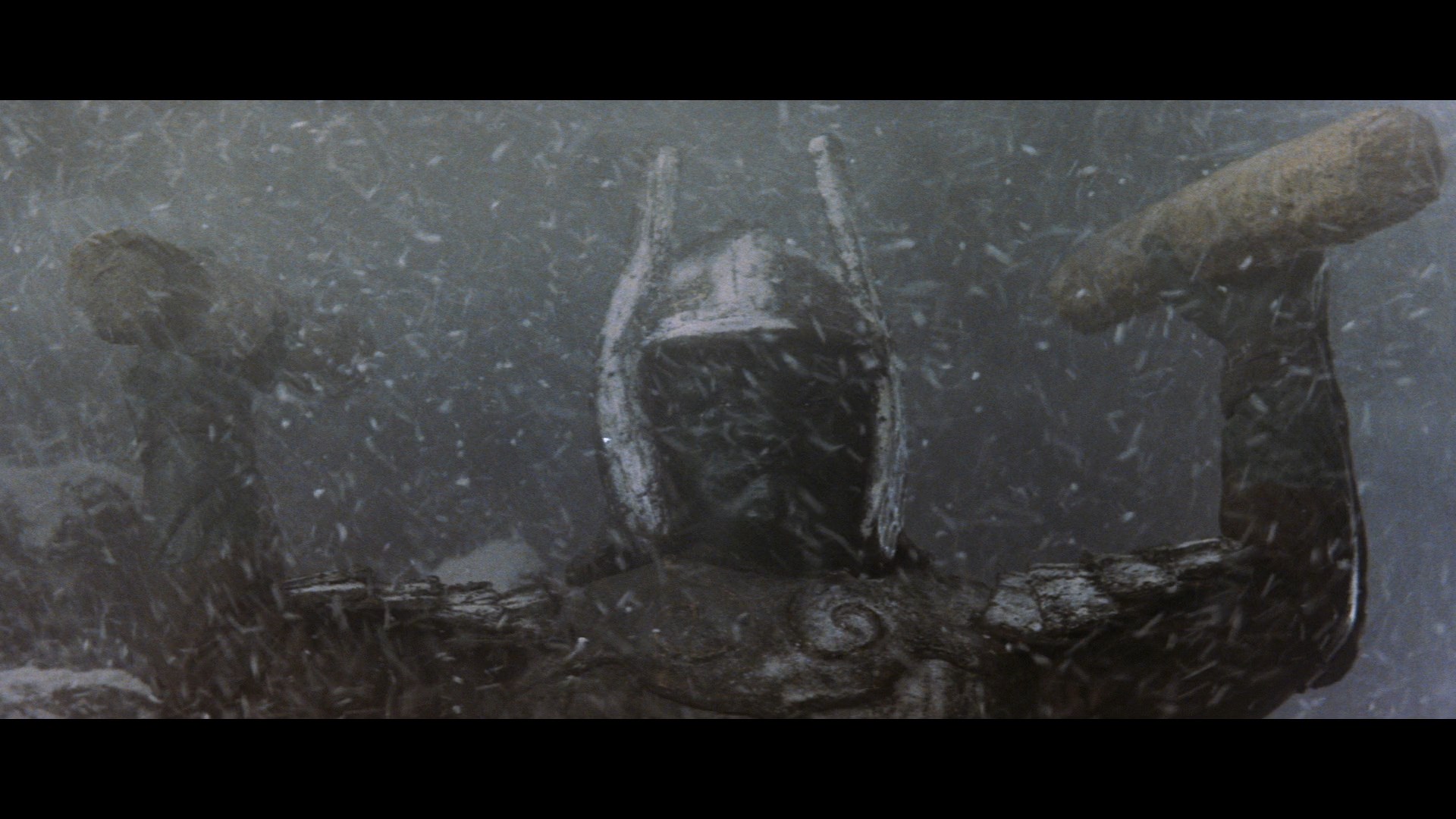 variation on "an hour and a bit of oppression, and then a monster rampage at the end" while using the more methodical pacing to focus on conveying the scale of the special effects more carefully than usual when they erupt. In the video essay "Bringing the Avenging God to Life" (17m11s), Ed Godziszewski offers a very engaging overview of the creation of the monster under the guidance of veteran Yoshiyuki Kuroda with a team hard at work pulling off some tricky illusions and contending with elements on set like potato dust. Also included are the U.S. Majin credits (in both 2.35:1 and 1.33:1 presentations), Japanese trailers (standalone and paired up with Gamera vs. Barugon), two U.S. TV spots, and a 48-image gallery. Return features "My Summer Holidays with Daimajin" (33m45s), a new video interview with Professor Yoneo Ota, director of the Toy Film Museum, Kyoto Film Art Culture Research Institute, which starts with a quick survey of his work (including the salvaging of Japanese silent cinema scraps) and launches into a colorful history of Daiei and these films' placement in its history. "From Storyboard to Screen: Bringing Return of Daimajin to Life" (3m54s) is a comparison of several key scenes, with 8 storyboards also included separately. You also get the U.S. credits in both aspect ratios again, the Japanese trailer, a U.S. TV spot, and a 31-image gallery. Finally Wrath has an interview with Morita (87m29s), which is actually a stitching together of the great three-part featurettes seen earlier on the Mill Creek set-- here swapping out English-language text cards for the hard-to-read subtitled Japanese ones we saw before. Also included are the Japanese trailer and teaser, plus a 20-image gallery.
variation on "an hour and a bit of oppression, and then a monster rampage at the end" while using the more methodical pacing to focus on conveying the scale of the special effects more carefully than usual when they erupt. In the video essay "Bringing the Avenging God to Life" (17m11s), Ed Godziszewski offers a very engaging overview of the creation of the monster under the guidance of veteran Yoshiyuki Kuroda with a team hard at work pulling off some tricky illusions and contending with elements on set like potato dust. Also included are the U.S. Majin credits (in both 2.35:1 and 1.33:1 presentations), Japanese trailers (standalone and paired up with Gamera vs. Barugon), two U.S. TV spots, and a 48-image gallery. Return features "My Summer Holidays with Daimajin" (33m45s), a new video interview with Professor Yoneo Ota, director of the Toy Film Museum, Kyoto Film Art Culture Research Institute, which starts with a quick survey of his work (including the salvaging of Japanese silent cinema scraps) and launches into a colorful history of Daiei and these films' placement in its history. "From Storyboard to Screen: Bringing Return of Daimajin to Life" (3m54s) is a comparison of several key scenes, with 8 storyboards also included separately. You also get the U.S. credits in both aspect ratios again, the Japanese trailer, a U.S. TV spot, and a 31-image gallery. Finally Wrath has an interview with Morita (87m29s), which is actually a stitching together of the great three-part featurettes seen earlier on the Mill Creek set-- here swapping out English-language text cards for the hard-to-read subtitled Japanese ones we saw before. Also included are the Japanese trailer and teaser, plus a 20-image gallery.![]()